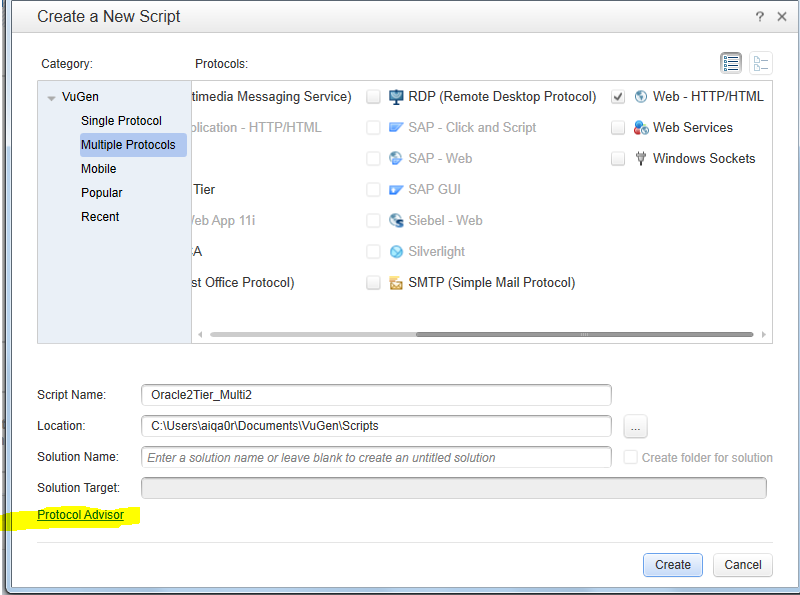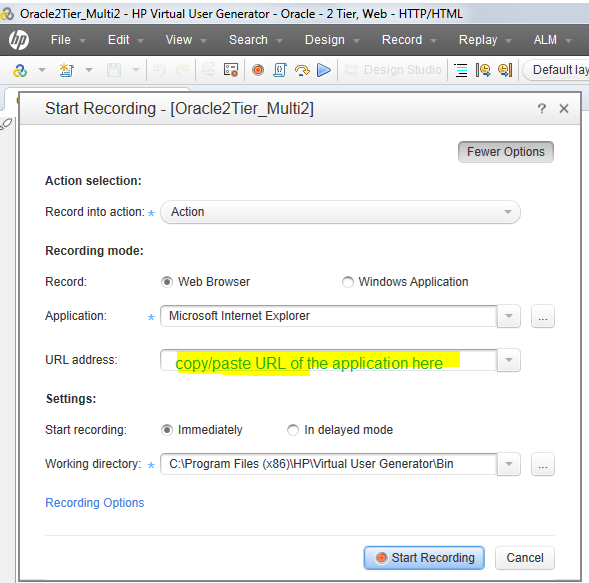HP LoadRunner – how to use Virtual user generator.
1) Under Windows menu >> HP Software >> Click on Virtual user generator menu to open HP Virtual user generator application (if you already have HP LoadRunner is installed on machine)

2) Select the protocol – refer Snapshot 1 below.
Note 1: if you are not sure about the protocol, use the protocol adviser in the “Virtual user generator” application and scan the application to find out best matching protocols (refer Snapshot 2 below)
Note 2: for web applications usually “Web – HTTP/HTML” is the protocol, you add additional protocols for database e.g ODBC or Oracle.
Snapshot 1

Snapshot 2

3) Click on create button in the above snapshot 2. Enter url as copied below in snapshot 3. Then Click start recording
Snapshot 3

4) Once your application pop us – start doing the business transactions which you wanted to do. You will see recording status is updated as below (adding time – below snapshot 4 shows 2.58 min recording )
Snapshot 4

5) Once the code is developed – HP LoadRunner Controller is used to setup the scenario – refer the Performance best practices to get the flow.
HP LoadRunner – how to use Virtual user generator.
1) Under Windows menu >> HP Software >> Click on Virtual user generator menu to open HP Virtual user generator application (if you already have HP LoadRunner is installed on machine)

2) Select the protocol – refer Snapshot 1 below.
Note 1: if you are not sure about the protocol, use the protocol adviser in the “Virtual user generator” application and scan the application to find out best matching protocols (refer Snapshot 2 below)
Note 2: for web applications usually “Web – HTTP/HTML” is the protocol, you add additional protocols for database e.g ODBC or Oracle.
Snapshot 1

Snapshot 2
3)

Click on create button in the above snapshot
2. Enter url as copied below in snapshot
3. Then Click start recording
Snapshot 3

4) Once your application pop us – start doing the business transactions which you wanted to do. You will see recording status is updated as below (adding time – below snapshot 4 shows 2.58 min recording )
Snapshot 4

5) Once the code is developed – HP LoadRunner Controller is used to setup the scenario – refer the Performance best practices to get the flow.
LoadRunner version 12.53
I am yet to try the trial version of LoadRunner 12.53, However I read the following are some of the features shall be available for users
Git integration in VuGen
REST step builder editor in VuGen
64-bit replay support in various Java protocols and C Vuser protocol
New PCoIP remote access protocol
Enhanced SAPUI5 recording in TruClient
HTTP Video Streaming (HTML5, HLS) support
JSON manipulation APIs
Web – HTTP/HTML and Mobile Application – HTTP/HTML protocol unification
Linux load generator improvements
Enhancements to Java-based protocols etc are main features that I would like to try..
Load balancing testing.
Load balancing is a method of balancing the network traffic to make sure network transactions are distributed across all the servers. for e.g if a server fails during heavy applied in them, load balancer will redirect the transactions to remaining servers. Basically Load balance acts as a reverse proxy. During performance testing this feature is tested usually.
Performance testing vs Load testing vs Stress testing vs Endurance testing
1. Performance testing – The main purpose of Performance testing is to arrive the benchmark & baseline of the system behavior (e.g response time) under normal/moderate load. This test will help performance engineer to analyse how does the application behave under normal conditions.
2. Load testing – here load will be constantly and steadily increased over a given period of time. i.e the constant load applied for a constant period of time. For example a load of 100 users are applied for 15 min.
3. Stress test – it is meant to push the system beyond the normal load limits or extreme conditions. This test is to make sure the servers don’t crash or what point it crashes. Stress test will verify the breaking point of the system or how much load, system can withstand.
For example a load of 100 users are applied for 15 min and then 150 users load is applied for next 15 min. then 200 users load is applied for next 15 min. Verify at what point system stopped to respond.
4. Endurance testing – for easy understanding, I would say it is a “Load testing on extended period” to make sure web servers are performing longer period of time. For example a load of 100 users are applied for 48 hours
Note: Once the performance testing is completed successfully, tester can assume the performance requirements are met and he can start load testing. After that Stress testing if required.
Load testing tools in the market are
1) HPE LoadRunner is from Hewlett Packard Enterprise.
2) JMeter – Apache JMeter. It is a Java based performance testing tool works on web communication layer (HTTP)
Loadrunner components
Vuser generator – used for generating Scripts
Controller – used for creating and executing scenarios
Analyzer – used for analyzing results
Performance test analysis can be done real time script execution or post execution
Real time script execution analysis
1) Performance Engineer needs a coordination with other teams like Database team, app server team, etc to monitor real time performance on Database server, Application server
2) Database and app server team can let Performance Engineer know the performance results on these servers like resource utilization, fail over server works / load balancing works fine etc.
Post script execution analysis
1) Verification on Vuser metrics, Vuser errors, can be validated.
2) Verification Transactions graphs for TPS, response time, hits per second can be reviewed.
For additional details please click on click link load testing vs performance testing vs stress testing
Performance testing best practices and activities.
Performance test analysis.
What is Performance test analysis?
Performance test analysis can be done real time script execution or post execution
Real time script execution analysis
1) Performance Engineer needs a coordination with other teams like Database team, app server team, etc to monitor real time performance on Database server, Application server
2) Database and app server team can let Performance Engineer know the performance results on these servers like resource utilization, fail over server works / load balancing works fine etc.
Post script execution analysis
1) Verification on Vuser metrics, Vuser errors,
2) Verification Transactions graphs for TPS, response time, hits per second etc.
For additional details please click on click link https://agileonit.com/load-testing-vs-performance-testing-vs-stress-testing/
Performance testing best practices and activities.
- As first step, Performance Engineer needs to learn the requirements, performance expectations & system architecture.
Note: To learn the performance requirements & expectations, SME (Subject matter expert ) or production user can help. This information will help to define performance goals and SLAs
- Then develop best matching performance test scenarios, approach, define goals (SLAs) & sign off test plan.
Note 1: To identify the right performance test scenarios, SME can give some feedback on about the current performance issues in production / live application that he/she is facing.
Note 2: You can refer another blog of mine on different types of performance scenarios – click link load testing vs performance testing vs stress testing
- Now Performance Engineer can developer V– USER scripts and execute the scripts in Controller to generate performance analysis results
Note 1: Apart from delivering performance analysis results, Performance Engineer can coordinate with other team to monitor real time performance on Database server, Application server and also make sure load balancing is working fine while stress testing.
Some of the e.g. when performance testing is needed
- for Database upgrade,
- Application upgrade,
- Or if user complains that application performance is bad – like page response is not meeting his/her expectations.